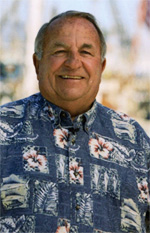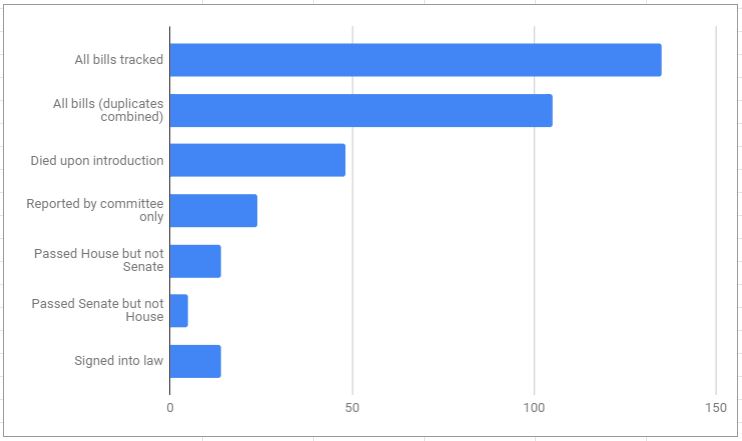An Interview with Don Hansen: The whale watching business

This is the third and last part of our interview with Don Hansen, who has been involved in the Council process since it started in 1976.

I started whale watching on the West Coast. Phil Grignon down at San Clemente high school here, had his biology class looking at whales. We had the boats, and he had the kids, so we started whale watching in the early ’50s. We just took school kids in 1950, and then we built up from that where we have a festival of whales every year. [It’s] all up and down the West Coast now, everybody’s whale watching. But we were the first. NOAA’s got rules and regulations on it, but the whales don’t read the rules and regulations. If you shut the boat down, they’ll come up to you if they’re inquisitive at all – and they are very inquisitive. They’ll just come right up to the boat. We’ve had them blow on the kids and everything else.
Once I was following a mother and a calf, at a safe distance, but I got between the calf and the mother. Not intentionally, it just happened. And she turned on me, and flipped her tail and hit the boat. Splashed the people and told me “stay away from my baby.” That was scary. I’d never had that happen. I didn’t intend to separate the two of them, it just happened. The baby came this way and the mother decided she didn’t like it, so she told me to get away. Yes, ma’am. I did.
You know, going back into whaling. One of the original Council members was [a whaler.] His grandson is on an advisory panel now. Hunter. Gibb Hunter. He was one of the original Council members, and he was a whaler. One of the last whaling boats out of Eureka.
The schoolkids here in Southern California, San Clemente High School, were part of getting the whale listed as endangered—the gray whale—and then, when they recovered, they were a part of the program to de-list it. When you go on the endangered species list it’s almost impossible to get off the list. But they were part of the listing and part of the delisting. It was quite a program they put together.
There’s a lot more whales, different whales now. We’re seeing with the ocean conditions changing like they are, we’re seeing lots of blue whales, which are the biggest mammal in the world. We’ve seen those more now than we’ve ever seen them, and there’s more and more humpbacks on the coast here than there used to be. And you’ve got minke whales, and then you have the normal gray whales going up and down the coast. And lots and lots and lots and lots and lots and lots of dolphins. Tons and tons of dolphins. Both common and white-sided.
And then you get the killer whales down here too, the orcas down here. One of the things they love to eat is sea lions. I’ve been trying to tell them, for years, to come down here. They could feed for months, years—a lifetime down here. Learn how to eat the sea lions.
But the main thing is, we’ve accomplished a lot in these last 50 years. We’ve rebuilt stocks, we’ve brought people together, we’ve done a lot of important things. I really want to thank everyone I’ve worked with over the years, from Bill Fox and Charlie Fullerton years ago to Chris Oliver now at NOAA. And the executive directors all the way back to the beginning, and of course the great Council staff, and everyone else who has contributed through those years. We’ve done some great things. I’m really proud to have been part of this process.
An overview of fishery bills in the 116th Congress

As of December 10, the Council has tracked 105 bills in the 116th Congress relating to West Coast fisheries, habitat, and management. Of these, 48 bills were introduced but went nowhere; 24 were reported by committee but never progressed; 14 passed the House but not the Senate; and five passed the Senate but not the House.
Fourteen bills were signed into law, or have passed both the House and Senate and are due to be signed in the near future. These include S. 47, the John D. Dingell, Jr. Conservation, Management and Recreation Act, which included the WILD Act, the Sacramento-San Joaquin Delta National Heritage Area Act, and the Frank and Jeanne Moore Wild Steelhead Special Management Area Designation Act; the Columbia River In-Lieu and Treaty Fishing Sites Improvement Act; the Maritime Security and Fisheries Enforcement Act (as part of the National Defense Authorization Act); the Great American Outdoors Act; America’s Conservation Enhancement Act, which included the National Fish Conservation Through Partnerships Act; a bill to amend the Klamath Basin Water Supply Enhancement Act; the Save Our Seas 2.0 Act; the Digital Coast Act; and the National Sea Grant College Amendments Act. On December 10, the Drift Gillnet Modernization Act (S. 906) passed the House, signaling that it will be signed in the near future (see related story below).
Topics that did not pick up traction in the 116th Congress included Magnuson-Stevens Act reauthorization, Coronavirus relief for fishing communities, climate change and ocean acidification, coral protection, prohibiting oil drilling off the West Coast, transfering management of anadromous species to the U.S. Fish and Wildlife Service, changing the management of forage fish, addressing fishery disaster declarations, promoting marine energy research, reforming maritime liens, labeling or prohibiting genetically modified salmon, and preventing international trade in shark fins.
Driftnet Modernization and Bycatch Reduction Act sent to President for signature
On December 10, the House passed Senator Diane Feinstein and Representative Ted Lieu’s (both D-CA) Driftnet Modernization and Bycatch Reduction Act, sending it to the President to be signed into law. The bill, which passed the Senate on July 22, extends current California state regulations regarding driftnets to all Federal waters within five years. Meanwhile, the Department of Commerce will be required to conduct a transition program to phase out large-scale driftnet fishing and to promote the adoption of alternative fishing practices.
The Council commented on the bill in September 2019.
Legislative Committee discusses Ocean-Based Climate Solutions Act
In November, the Council directed staff to track the Ocean-Based Climate Solutions Act and any related executive orders issued by the Biden Administration, in preparation for responding to any forthcoming requests for Council comment.
The Ocean Climate Solutions Act was introduced on October 20, 2020. The bill will continue to be shaped in the next Congressional session. The bill incorporates many separate (and often bipartisan) bills that were introduced during the 116th Congress. The sponsors of these bills are familiar to the Council – Roger Wicker, Jared Huffman, Lisa Murkowski, Suzanne Bonamici, Don Young, Marco Rubio, and more.
The primary issue of interest to the Council is the proposed policy “to prohibit any commercial extractive or destructive human activity and minimize the impact from human activity on 30 percent of the ocean” under U.S. jurisdiction by 2030.
Other sections of the bill focus on Blue Carbon (coastal habitats including mangroves, tidal marshes, kelp forests, and other tidal or saltwater wetlands that have the capacity to sequester atmospheric carbon), offshore energy, climate-ready fisheries, extending the Coastal Barriers Resources Act to the West Coast, amending the Coastal Zone Management Act, strengthening marine mammal conservation, tribal resilience, ocean acidification, harmful algal blooms, national ocean policy, data sharing, wetlands restoration, greenhouse gas emissions from shipping, whale strikes, and other topics.
Habitat Report: Offshore wind, aquaculture, salmon and beavers
Aquaculture opportunity areas
NOAA is soliciting comments on Aquaculture Opportunity Areas (AOAs) as part of the Executive Order on Promoting American Seafood Competitiveness and Economic Growth. The Order directs the Secretary of Commerce to establish ten AOAs nationwide by 2025. The first proposed areas are in the Southern California Bight and the Gulf of Mexico. NOAA plans to identify three to five sub-areas within each AOA for future aquaculture siting.
After the first two AOAs are identified, two additional AOAs must be identified in each of the following four years until there are a total of ten AOAs.
The Council is developing a comment letter identifying issues and concerns regarding siting of the proposed AOA in Southern California. Considerations include valuable fishing grounds, habitat areas of particular concern, Essential Fish Habitat Conservation Areas, and areas prone to hypoxia and harmful algal blooms.
The public comment deadline is December 22 (see notice in 85 Federal Register 67519 (Oct. 23, 2020)).
Salmon Rebuilding Plans
The Habitat Committee (HC) has been examining habitat issues that contributed to the overfishing status for Sacramento fall Chinook and Klamath River fall Chinook. They presented a list of life-stage-specific habitat indicators for Sacramento River fall Chinook, that includes 28 indicators and six life stages. For Sacramento River fall Chinook, data are available from the 1980s to the present.
Next, the HC will finalize these indicators and develop similar indicators for Klamath River fall Chinook.

Beaver management
The National Marine Fisheries Service (NMFS) recently consulted with the U.S. Department of Agriculture’s (USDA) Wildlife Services on the control of semiaquatic mammals in Washington and Oregon. The consultations were the result of a lawsuit, and include beaver and other aquatic mammals.
NMFS worked with the USDA to improve understanding of the importance of beavers in maintaining salmon habitat and to document and minimize the scope of lethal beaver removals.
Under the new program resulting from the consultations, lethal removal of beaver in Washington State is declining. Beaver removals in Oregon are currently paused pending a National Environmental Policy Act analysis. A new NMFS brochure promotes nonlethal beaver management techniques for landowners and resource managers.
Offshore Wind Energy
Responsible Offshore Development Alliance (RODA) recently conducted a webinar on offshore wind, focusing on the state of the science on wind-ocean ecosystem impacts. Since the webinar mainly focused on East Coast issues, the Pacific Coast Federation of Fishermen’s Associations has asked RODA to do a similar West Coast-focused webinar in the near future.
Advisory Body appointments
Oregon Council member Christa Svensson has been appointed as an alternate Commissioner to the Western and Central Pacific Commission (WCPFC), replacing Dorothy Lowman, who will continue to represent the United States as the Inter-American Tropical Tuna Commission (IATTC) co-chair of the IATTC-WCPFC Northern Committee Joint Working Group on bluefin tuna.
Anna Weinstein was appointed to the conservation position on the Coastal Pelagic Species Advisory Subpanel formerly held by Gillian Lyons; Gretchen Hanshew and Daniel Studt were appointed to the two National Marine Fisheries Service (NMFS) West Coast Region positions on the Groundfish Management Team (GMT) formerly held by Abigail Harley and Karen Palmigiano; Katherine Pierson was appointed to the Oregon Department of Fish and Wildlife position formerly held by Patrick Mirick on the GMT; and Dr. Chantel Wetzel was appointed to the vacant NMFS Northwest Fisheries Science Center position.
On the Groundfish Endangered Species Workgroup, Scott Benson was appointed to the Sea Turtle Taxa position formerly held by Dr. Tomo Eguchi; and Lynn Mattes was appointed to the vacant Oregon Department of Fish and Wildlife position.
On the Ad Hoc Groundfish Electronic Monitoring Committees, Andrew Torres will replace Brian Corrigan as the NMFS Office of Law Enforcement representative on the Technical Advisory Committee, and Mike Orcutt will replace Howard McElderry on the Policy Advisory Committee.